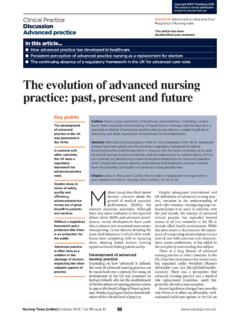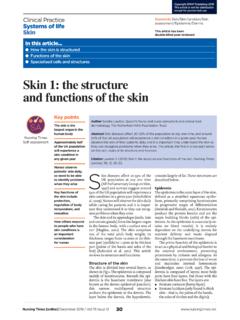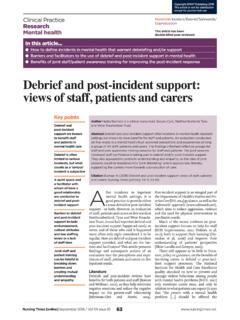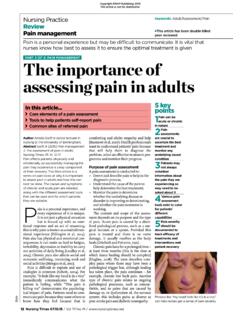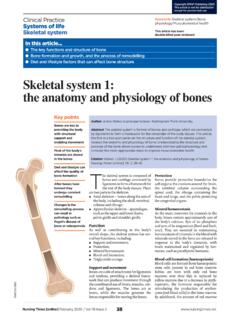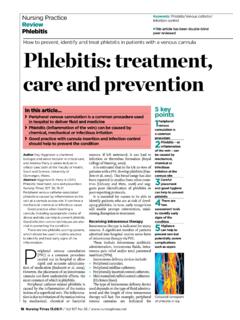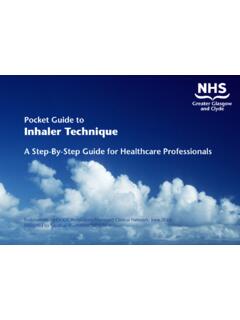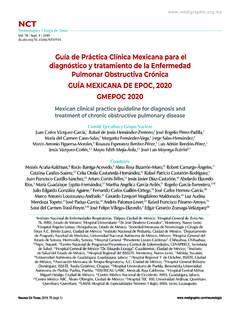Transcription of Diagnosis and management of COPD: a case study - EMAP
1 Copyright EMAP Publishing 2020 This article is not for distributionexcept for journal club use36 June 2020 / Vol 116 Issue 6 term chronic obstructive pul-monary disease (COPD) is used to describe a number of conditions, including chronic bronchitis and emphysema. Although common, prevent-able and treatable, COPD was projected to become the third leading cause of death globally by 2020 (Lozano et al, 2012). In the UK in 2012, approximately 30,000 people died of COPD of the total number of deaths ( ). By 2016, information published by the World Health Organization ( ) indicated that Lozano et al (2012) s projec-tion had already come true. People with COPD experience persis-tent respiratory symptoms and airflow limitation that can be due to airway or alveolar abnormalities, caused by signifi-cant exposure to noxious particles or gases, commonly from tobacco smoking.
2 The projected level of disease burden poses a major public-health challenge and pri-mary care nurses can be pivotal in the early identification, assessment and manage-ment of COPD (Hooper et al, 2012). Grace Parker (the patient s name has been changed) attends a nurse-led COPD clinic for routine reviews. A widowed, 60-year-old, retired post office clerk, her main complaint is breathlessness after moderate exertion. She scored 3 on the modified Medical Research Council (mMRC) scale (Fletcher et al, 1959), indi-cating she is unable to walk more than 100 yards without stopping due to breath-lessness. Ms Parker also has a cough that produces yellow sputum (particularly in the mornings) and an intermittent wheeze.
3 Her symptoms have worsened over the last six months. She feels anxious leaving the house alone because of her breathless-ness and reduced exercise tolerance, and scored 26 on the COPD Assessment Test (CAT, ), indicating a high level of impact. Ms Parker smokes 10 cigarettes a day and has a pack-year score of 29. She has not experienced any haemoptysis (coughing up blood) or chest pain, and her weight is stable; a body mass index of 40kg/m2 means she is classified as obese. She has had three exacerbations of COPD in the previous 12 months, each managed in the community with antibiotics, steroids and COPD/Spirometry/Lifestyle interventions/Self- management This article has been double-blind peer reviewedKey points Chronic obstructive pulmonary disease is a progressive respiratory condition, projected to become the third leading cause of death globallyDiagnosis involves taking a patient history and performing spirometry testingSpirometry identifies airflow obstruction by measuring the volume of air that can be exhaled Chronic obstructive pulmonary disease is managed with lifestyle and pharmacological interventions.
4 As well as self-managementDiagnosis and management of COPD: a case studyAuthors Debbie Price is lead practice nurse, Llandrindod Wells Medical Practice; Nikki Williams is associate professor of respiratory and sleep physiology, Swansea This article uses a case study to discuss the symptoms, causes and management of chronic obstructive pulmonary disease, describing the patient s associated pathophysiology. Diagnosis involves spirometry testing to measure the volume of air that can be exhaled; it is often performed after administering a short- acting beta-agonist. management of chronic obstructive pulmonary disease involves lifestyle interventions vaccinations, smoking cessation and pulmonary rehabilitation pharmacological interventions and Price D, Williams N (2020) Diagnosis and management of COPD: a case study .
5 Nursing Times [online]; 116: 6, this A case study of a patient with chronic obstructive pulmonary disease Pathophysiology and Diagnosis , including spirometry How the condition is managed through interventions and self-managementClinical PracticeCase studyRespiratoryCopyright EMAP Publishing 2020 This article is not for distributionexcept for journal club use37 June 2020 / Vol 116 Issue 6 normal for spirometry param-eters but the lower limit of normal equal to the fifth percentile of a healthy, non-smoking population based on more robust statistical models is increasingly being used (Cooper et al, 2017). A reversibility test involves performing spirometry before and after administering a short- acting beta-agonist (SABA) such as salbutamol; the test is used to distinguish between reversible and fixed airflow obstruction.
6 For symptomatic asthma, air-flow obstruction due to airway smooth-muscle contraction is reversible: adminis-tering a SABA results in smooth-muscle relaxation and improved airflow (Lumb, 2016). However, COPD is associated with fixed airflow obstruction, resulting from neutrophil-driven inflammatory changes, excess mucus secretion and disrupted alveolar attachments, as opposed to airway smooth-muscle contraction. Administering a SABA for COPD does not usually produce bronchodilation to the extent seen in someone with asthma: a person with asthma may demonstrate sig-nificant improvement in FEV1 (of >400ml) after having a SABA, but this may not change in someone with COPD (NICE, 2018).
7 However, a negative response does not rule out therapeutic benefit from long-term SABA use (Mar n et al, 2014). NICE (2018) and GOLD (2018) guidelines advocate performing spirometry after administering a bronchodilator to diag-nose COPD. Both suggest a FEV1/FVC of <70% in a person with respiratory symp-toms supports a Diagnosis of COPD, and both grade the severity of the condition using the predicted FEV1. Ms Parker s spirometry results showed an FEV1/FVC of 56% and a predicted FEV1 of 57%, with no significant improvement in these values with a reversibility test. GOLD (2018) guidance is widely accepted and used internationally. However, it was developed by medical practitioners with a medicalised approach, so there is potential for a bias towards pharmacological man-agement of COPD.
8 NICE (2018) guidance may be more useful for practice nurses, as it was developed by a multidisciplinary team using evidence from systematic reviews or meta-analyses of randomised controlled trials, providing a holistic approach. NICE guidance may be outdated on publication, but regular reviews are per-formed and published online. NHS England (2016) holds a national register of all health professionals certified in spirometry. It was set up to raise spirom-etry standards across the country. delicately balanced activity of these enzymes, resulting in the parenchymal damage and small airways (with a lumen of <2mm in diameter) airways disease that is characteristic of emphysema.
9 The severity of parenchymal damage or small airways disease varies, with no pattern related to disease progression (Global Ini-tiative for Chronic Obstructive Lung Dis-ease, 2018).Ms Parker also had a wheeze, heard through a stethoscope as a continuous whistling sound, which arises from turbu-lent airflow through constricted airway smooth muscle, a process noted by Mitchell (2015). The wheeze, her 29 pack-year score, exertional breathlessness, cough, sputum production and tiredness, and the findings from her physical exami-nation, were consistent with a Diagnosis of COPD (GOLD, 2018; NICE, 2018).
10 SpirometrySpirometry is a tool used to identify airflow obstruction but does not identify the cause. Commonly measured parameters are: Forced expiratory volume the volume of air that can be exhaled in one second (FEV1), starting from a maximal inspiration (in litres); Forced vital capacity (FVC) the total volume of air that can be forcibly exhaled at timed intervals, starting from a maximal inspiration (in litres). Calculating the FEV1 as a percentage of the FVC gives the forced expiratory ratio (FEV1/FVC). This provides an index of air-flow obstruction; the lower the ratio, the greater the degree of obstruction. In the absence of respiratory disease, FEV1 should be 70% of FVC.
